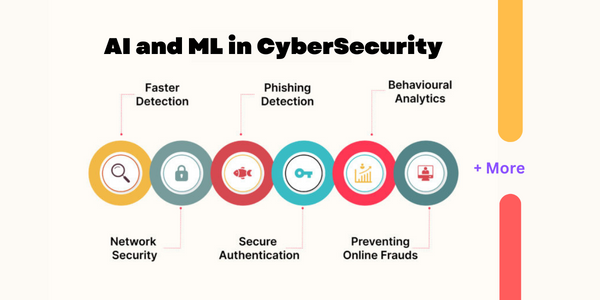Introduction
AI and ML have rapidly become some of the most essential technologies in the field of cybersecurity. With the increasing amount of data and sophisticated cyber threats, AI and ML are used to strengthen the security of organizations and individuals. They help analyze large amounts of data and identify patterns that may indicate the presence of a cyber threat. This allows organizations to detect and respond to cyber threats more quickly and accurately than traditional methods. In this article, we will explore the important applications of AI in cyber security and the future potential of these technologies.

Learning Objectives
- To understand cybersecurity.
- To understand the application of AI and ML in cybersecurity in depth.
- Skills to apply AI and ML to security problems and the disadvantages.
This article was published as a part of the Data Science Blogathon.
Table of contents
What is Cybersecurity?
Cybersecurity protects internet-connected systems, including hardware, software, and data, from attack, damage, or unauthorized access. The importance of cybersecurity has grown in recent years as more and more of our daily activities and important information are stored and transmitted online.
Cybersecurity threats exist, including hacking, malware, phishing, and ransomware. Hacking refers to unauthorized access to a computer system or network. Malware is software specifically designed to harm or exploit a computer or network. Phishing is the attempt to acquire sensitive information such as usernames, passwords, and credit card details by disguising oneself as a trustworthy entity in an electronic communication. Ransomware is malware that encrypts a victim’s files and demands payment in exchange for the decryption key.
It is important for individuals, businesses, and governments. Individuals must protect personal information such as financial data, identification numbers, and login credentials from cyber criminals. For businesses, it is important to protect sensitive business information and ensure continuity of operations in case of a cyber attack. Cybersecurity is also critical for government and military operations, as a cyber attack on their systems can severely affect national security.

Traditional Approach to Cybersecurity Before AI
Before AI, cybersecurity largely relied on traditional approaches. Organizations employed rule-based systems and signature-based detection methods to identify known threats like viruses and malware. These methods were limited in handling evolving and sophisticated cyber threats. Human analysts manually reviewed logs and data, often leading to delayed responses and missed vulnerabilities. The lack of automation and real-time analysis made it challenging to counter rapidly changing attack techniques. Additionally, the inability to handle vast amounts of data hindered effective threat detection and response. As cyber threats became more complex, the traditional approach struggled to keep up, underscoring the need for a more dynamic and proactive solution.
How AI is Different From Traditional Approaches to Cybersecurity?
AI brings a paradigm shift in cybersecurity, distinct from traditional approaches. Here’s how AI differs from conventional methods:
Proactive Detection
AI employs machine learning algorithms to analyze vast datasets and detect subtle anomalies, including previously unknown threats, whereas traditional methods mainly rely on predefined signatures or rules.
Adaptive Learning
AI systems continuously learn from new data, adapting to evolving attack patterns and staying ahead of attackers. In contrast, traditional approaches may need help to keep up with rapidly changing tactics.
Behavioral Analysis
AI observes user and system behavior, detecting deviations from established norms. Using rule-based systems, this behavioral analysis identifies unusual activities that may not trigger alerts.
Pattern Recognition
AI excels at recognizing complex attack patterns across diverse data sources, even when attackers disguise their actions. Traditional methods might miss such disguised threats.
Reduced False Positives
AI’s self-learning capability enables it to reduce false positives by refining its understanding of what constitutes normal behavior, leading to more accurate threat detection.
Real-Time Response
AI automates real-time threat response by instantly flagging and neutralizing suspicious activities. Traditional methods may require manual intervention, leading to slower responses.
Threat Hunting
AI-driven analytics enable proactive threat hunting, actively seeking out hidden threats and vulnerabilities within the system, which traditional methods often overlook.
Prediction and Prevention
AI forecasts potential threats based on historical and real-time data, enabling organizations to implement preventive measures. Traditional methods are more reactive.
Scalability
AI scales effortlessly to analyze massive amounts of data, which is ideal for the high-volume environments of modern cybersecurity. Traditional approaches may struggle with such scalability.
Learning from Experience
AI models learn from past incidents and improve over time, becoming more effective with each iteration. Traditional methods rely on the expertise of human analysts without the same learning curve.
Complexity Handling
AI can handle complex and multifaceted attack strategies, including polymorphic malware and advanced persistent threats, which can evade traditional defenses.
Minimized Human Bias
AI-based decisions are devoid of human bias, providing impartial and consistent threat assessment, whereas traditional approaches might be influenced by human judgments.
Application of AI in Cybersecurity
Here is a few potential application of AI and Machine Learning in Cybersecurity:
Using ML For Malware Detection and Classification
AI in cybersecurity contributes to detecting and classifying malware. Machine learning algorithms can be trained to recognize the characteristics of different types of malware, such as viruses, worms, and trojans. This enables the system to detect and classify new malware in real-time, even if it has not been previously seen. You can also read this article for more information.
Adversarial ML and its Implications for Cybersecurity
Adversarial machine learning is another area of AI and ML that has implications for cybersecurity. This approach involves training machine learning models to recognize and defend against adversarial examples, which are inputs specifically crafted to fool the model. In cybersecurity, adversarial machine learning can be used to detect and defend against adversarial attacks, such as those that attempt to evade intrusion detection systems or fool a system into misclassifying malware as benign.

AI-based Network Traffic Analysis and Anomaly Detection
AI and ML are also used in network traffic analysis and anomaly detection. These systems use machine learning algorithms to analyze network traffic and detect anomalies, which may indicate a potential intrusion. For example, a system can use ML to detect a sudden increase in traffic from a specific IP address or to identify network activity patterns indicative of a particular type of attack.
AI-assisted Penetration Testing and Vulnerability Management
Penetration testing and vulnerability management are also areas where AI and ML are used. Penetration testing is the process of attempting to gain unauthorized access to a system or network. At the same time, vulnerability management is the process of identifying, evaluating, and mitigating vulnerabilities in a system or network. Machine learning algorithms can be used to automate both of these processes, making them more efficient and effective.
Real-time Threat Intelligence with Machine Learning
In cybersecurity, real-time threat intelligence is another area where AI and ML are used. These systems use machine learning algorithms to analyze data from various sources and provide real-time threat intelligence. This enables organizations to identify and respond to emerging threats quickly.
AI-powered Security Automation and Orchestration
AI-powered security automation and orchestration is another area where AI and ML are used. These systems use machine learning algorithms to automate repetitive security tasks, such as patch management and incident response. This enables organizations to free up human resources and focus on more important tasks.
AI-based User and Entity Behavior Analytics
AI-based user and entity behavior analytics (UEBA) is another area in which AI and ML are used in cybersecurity. These systems use machine learning algorithms to analyze the behavior of users and entities on a network. This enables organizations to detect anomalies and identify potential threats, such as insider threats and advanced persistent threats (APTs).
AI-Powered Cyber Threat Hunting
AI-powered cyber threat hunting is an emerging application of AI and ML in cybersecurity that aims to detect and respond to advanced threats that have evaded traditional security systems. The goal of threat hunting is to identify and stop malicious actors before they can cause damage to an organization.
Source: Centre for research and evidence on security threats
One of the main advantages of AI-powered threat hunting is its ability to analyze large volumes of data and identify patterns that may indicate a threat. Machine learning algorithms can be trained to recognize the characteristics of different types of threats, such as malware, phishing, or Advanced Persistent Threats (APTs). This enables the system to detect and classify new threats in real-time, even if they have not been previously seen.
AI And ML in Intrusion Detection and Prevention Systems
One of the most significant ways that AI and ML are used in cybersecurity is through intrusion detection and prevention systems (IDPS). These systems use machine learning algorithms to analyze network traffic and detect anomalies, which may indicate a potential intrusion. For example, an IDPS can use ML to detect a sudden increase in traffic from a specific IP address or to identify network activity patterns indicative of a particular type of attack.
Future of AI in Cybersecurity

The future potential of AI and ML in cybersecurity is vast and exciting. Here are a few examples of how these technologies could be used in the future to enhance the security of organizations and individuals:
Autonomous Security Systems
AI and ML could be used to create autonomous security systems that can operate independently and make decisions without human intervention. This would enable organizations to respond to threats in real-time, even if human operators are unavailable.
Predictive Threat Intelligence
AI and ML could be used to analyze data from various sources and provide predictive threat intelligence. This would enable organizations to anticipate and prepare for emerging threats before they happen.
Advanced Threat Hunting
AI and ML could be used to create advanced threat-hunting systems that can detect and respond to unknown threats. This would enable organizations to stay ahead of attackers who are constantly evolving their tactics.
AI-Driven Incident Response And Forensics
AI and ML could be used to automatically analyze data from various sources, such as network traffic, endpoint data, and logs, to identify and respond to threats in real time. This would enable organizations to contain and investigate incidents quickly.
Automated Compliance And Governance
AI and ML could be used to automate the compliance and governance process by automatically monitoring and reporting on security controls and identifying potential violations.
AI-Powered Security Automation And Orchestration
AI and ML could be used to automate repetitive security tasks, such as patch management and incident response, which would free up human resources and focus on more important tasks.
The Intersection of AI And Blockchain
Combining AI and blockchain technology could provide a more secure and decentralized approach to cybersecurity, especially in the areas of identity and access management, secure data sharing, and secure payment systems.
AI-Driven Security Operations Centers (SOC)
AI and ML could be used to improve the efficiency and effectiveness of security operations centers (SOCs) by automating repetitive tasks, analyzing data from various sources, and providing real-time threat intelligence.
Disadvantages of Using AI And Machine Learning in Cybersecurity

- High Cost: Implementing and maintaining AI and Machine Learning systems can be expensive. Organizations must invest in the necessary hardware, software, and expertise to deploy and manage the system.
- Complexity: AI and Machine Learning systems require specialized knowledge and skills to set up, configure, and operate.
- Dependence On Data Quality: The effectiveness of AI and Machine Learning in cybersecurity depends on the quality of the data used to train the machine learning algorithms.
- Limited Scope: AI and Machine Learning systems focus on identifying known threats, but they may not be able to detect new, unknown threats.
- Lack Of Transparency: AI and Machine Learning systems use complex algorithms that can be difficult to understand and interpret.
- False Positive And False Negative Alerts: Due to the complexity of the machine learning algorithms, AI and Machine Learning systems may generate many false positive and false negative alerts.
- Lack Of Human Oversight: AI and Machine Learning systems can be autonomous, meaning they don’t require human intervention.
- Vulnerability To Adversarial Attacks: AI and Machine Learning systems can be vulnerable to adversarial attacks, where malicious actors try to manipulate the input data to evade detection or mislead the system.
- Lack Of Explainability: AI and Machine Learning systems may be unable to explain how they arrived at a decision, making it difficult to understand and trust the results.
Conclusion
AI and ML are becoming increasingly important in the field of cybersecurity, as we have seen above. These technologies are being used to strengthen the security of organizations and individuals by automating repetitive tasks, detecting and classifying malware, analyzing network traffic, and identifying potential threats.
- The future potential of AI and ML in cybersecurity is also promising, with the potential to automate even more tasks and make systems more efficient and effective.
- Organizations should carefully consider these factors when implementing AI and ML in cybersecurity and ensure they are used in conjunction with other security practices.
Frequently Asked Questions
A. AI is used in cybersecurity to detect, prevent, and respond to cyber threats. Machine learning algorithms analyze patterns in data to identify anomalies, predict attacks, and enhance overall security measures.
A. Examples include AI-powered threat detection that identifies unusual user behaviors, machine learning models that predict malware behavior, and AI-driven automation that rapidly responds to security incidents.
A. Yes, AI is a crucial component of cybersecurity. It strengthens defense mechanisms by enabling real-time threat detection, automated incident response, and adaptive security strategies that keep up with evolving threats.
The media shown in this article is not owned by Analytics Vidhya and is used at the Author’s discretion.





